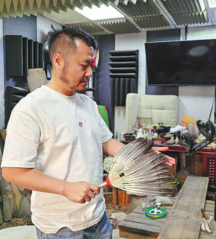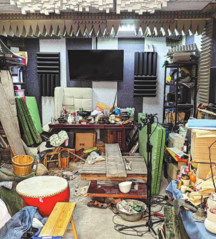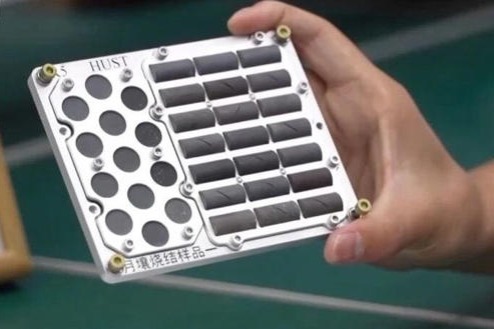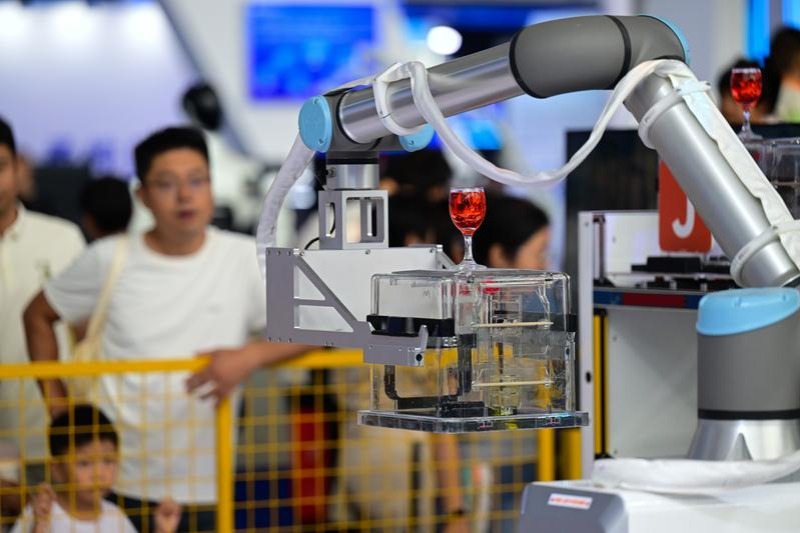Ensuring cinema sounds as good as it looks

QINGDAO, Shandong — In a 60-square-meter prop room in the port city of Qingdao, East China's Shandong province, a collection of seemingly worn-out items, including rusty chains, yellowed textbooks and mismatched enamel cups, awaits their moment to shine.
For Han Ruida, a Foley artist (named after an American, Jack Foley, who specialized in sound effects in the early years of Hollywood) with 16 years of experience, these are not just old junk, but treasures that breathe life into the world of cinema.
"Foley artists use a variety of props and techniques to re-create and interpret sounds that cannot be captured on set during film and television production," Han explains.
With a simple snap of celery, the sound of a bone breaking is perfectly synchronized with the visuals on screen. A piece of leather placed on a feather fan and vigorously waved can simulate the fluttering of birds in flight. Pouring sand from a salt shaker onto tin foil at different heights creates the ebb and flow of rain. Chewing on a mouthful of chive leaves brings to life the scene of a cow grazing.
Over the years, Han has explored the sonic potential of ordinary objects, using sound to "act" behind the scenes.
Sometimes, the challenge lies in creating sounds that are more vivid than reality. When footsteps on broken glass are needed, simply dropping ice cubes into a glass won't do. The sound lacks the desired expressiveness and texture.
After countless trials, Han found the right mix by adding leaves, plastic sheets, and fine sand to a basin of glass shards. The combination gave the sound a richer, more dynamic quality, turning ice into something far more expressive.
In 2017, Qingdao earned the title of UNESCO City of Film, becoming the first city in China to receive the honor. Since then, with major productions like The Wandering Earth filmed there, China's domestic film industry has taken significant strides toward industrialization.
The roles within the industry have grown increasingly specialized, and Foley artists, once seen as technical support, are now expected to think like directors and screenwriters, using sound to deepen storytelling and enrich the cinematic experience.
Even something as simple as footsteps holds a world of complexity. "Footsteps convey emotions. The sound of someone walking with enthusiasm is different from that of someone in sorrow. Children and the elderly also have distinct footsteps," Han says, adding that he once spent three years just studying the nuances of footsteps.
"While computer-generated sound effects can achieve basic results, it is the organic, lifelike sounds that truly touch people's hearts," he adds.
For Foley artists, real-life sounds are not just auditory stimuli; they are a wellspring of inspiration. When a sound that does not exist in reality is needed for a plot, the Foley artist becomes a "magician".
While working on a key prop sound for a science fiction film, Han tried rolling steel balls on different types of wood, but the results were unsatisfactory. Finally, he found a transformer at a scrapyard. The steel balls rolling on it produced a wide range of sound variations in a short time, creating the crucial sound needed for the plot.
Completing the Foley work for a film takes at least a month. Sometimes, just a few seconds of footage can correspond to hundreds of soundtracks.
Today, Han's sound library contains thousands of sounds he has collected himself, including wind, cicada chirps and the sound of his loved one combing her hair.
"Extracting sounds from the noisy world, deconstructing and refining them into individual elements, and then using them to complete and enrich more film and television works is a wonderful and magical process," Han says.
From film locations and production bases to a hub of the film industry, Qingdao has grown alongside China's film industry. Today, the port city is building a comprehensive film ecosystem that spans creative development, production, IP commercialization, and AI-powered collaboration. Data shows that from 2018 to 2024, among the top 50 domestic box-office hits, eight have production connections with Qingdao.
Xinhua


Today's Top News
- Japan's PM seen as playing to right wing
- Mainland increases entry points for Taiwan compatriots
- China notifies Japan of import ban on aquatic products
- Envoy: Japan not qualified to bid for UN seat
- Deforestation is climate action's blind spot
- Japan unqualified for UN Security Council: Chinese envoy






























